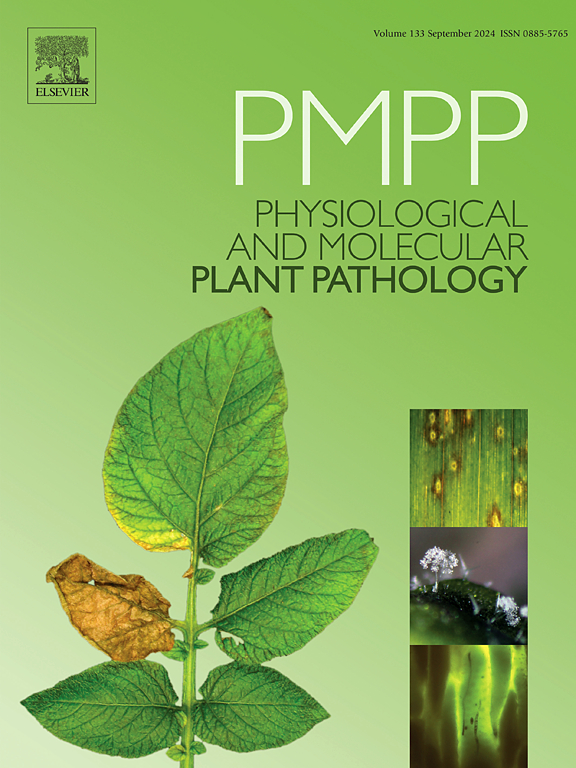硝酸钾诱导的生化防御对抗水稻真菌病原菌诱导的生物胁迫
IF 2.8
3区 农林科学
Q2 PLANT SCIENCES
引用次数: 0
摘要
本研究的重点是评估叶面施用钾盐(包括硝酸钾(KNO3)、氯化钾(KCl)和硫酸钾(K2SO4)对控制由曲霉和主要镰刀菌引起的水稻籽粒变色的效果。3次施用2% (w/v)硝酸钾可显著降低穗瘟病发病率和穗不孕症。3次施用@ 2%硝酸钾显著提高了2个水稻品种PR 114和PR 121的产量性状。与对照相比,施用2% (w/v)硝酸钾的植株蛋白质、总酚、丙二醛(MDA)、黄酮类化合物、单宁、多酚氧化酶(PPO)和苯氨裂解酶(PAL)的浓度均有不同程度的增加。脉冲调幅(PAM)叶绿素荧光研究表明,施用硝酸钾后,两个品种的光系统II能量通量(Fv/Fm和φPSII)均显著增加。施用@ 2%硝酸钾的品种PR 121的量子产率和φPSII最高,分别为0.891和1.450 Fv/Fm。结果表明,施用硝酸钾后,植株光合潜能增强,防御相关基因(体细胞胚胎发生受体激酶(SERK)、肉桂酸4-羟化酶(C4H)、超氧化物歧化酶(SOD)、组成型光形态发生调节因子(COP)、光受体A (PRA)、苯丙氨酸解氨酶(PAL)和苯丙类合成酶(PPS))表达增加。在PR121品种上喷施2% KNO3后,组成型光形态发生调节因子(2.658±0.75)和肉桂酸4-羟化酶(2.65±0.98)的相对基因表达倍数变化最大。本文章由计算机程序翻译,如有差异,请以英文原文为准。
Potassium nitrate-induces biochemical defense to combat biotic stress induced by fungal pathogens of rice (Oryzae sativa)
This study focused to assess the efficacy of foliar application of potassium salts including potassium nitrate (KNO3), potassium chloride (KCl) and potassium sulphate (K2SO4) in managing grain discoloration in rice caused by Aspergillus and major Fusarium species associated with this disease. Percent disease incidence and panicle sterility was significantly reduced with three applications of potassium nitrate 2 % (w/v). Three applications of potassium nitrate @2 % significantly enhanced the yield attributes of two rice varieties (PR 114, PR 121) under study. The plants sprayed with potassium nitrate 2 % (w/v) exhibited variable increase in concentrations of proteins, total phenols, malondialdehyde (MDA), flavonoids, tannins, polyphenol oxidase (PPO), and phenyl ammonia lyase (PAL) as compared to control. The pulse amplitude modulated (PAM) chlorophyll fluorometry studies revealed that the energy flux of photosystem II (Fv/Fm and φPSII) on plants sprayed with potassium nitrate was significantly increased in both the varieties under study. Maximum quantum yield and φPSII (0.891 and 1.450 Fv/Fm respectively) was observed on plants sprayed with potassium nitrate @2 % in variety PR 121. The results indicated that the plants sprayed with potassium nitrate exhibited enhanced photosynthetic potential leading to the increased expression of defense related genes (Somatic Embryogenesis Receptor Kinase (SERK), Cinnamate 4-hydroxylase (C4H), Superoxide dismutase (SOD), Constitutive Photomorphogenic regulator (COP), Photoreceptor A (PRA), Phenylalanine Ammonia-Lyase (PAL) and Phenylpropanoid Synthase (PPS). Maximum fold change values for relative gene expression were observed for Constitutive Photomorphogenic regulator (2.658 ± 0.75) and Cinnamate 4-hydroxylase (2.65 ± 0.98) in plants sprayed with KNO3 @ 2 % on variety PR121.
求助全文
通过发布文献求助,成功后即可免费获取论文全文。
去求助
来源期刊
CiteScore
4.30
自引率
7.40%
发文量
130
审稿时长
38 days
期刊介绍:
Physiological and Molecular Plant Pathology provides an International forum for original research papers, reviews, and commentaries on all aspects of the molecular biology, biochemistry, physiology, histology and cytology, genetics and evolution of plant-microbe interactions.
Papers on all kinds of infective pathogen, including viruses, prokaryotes, fungi, and nematodes, as well as mutualistic organisms such as Rhizobium and mycorrhyzal fungi, are acceptable as long as they have a bearing on the interaction between pathogen and plant.

 求助内容:
求助内容: 应助结果提醒方式:
应助结果提醒方式:


